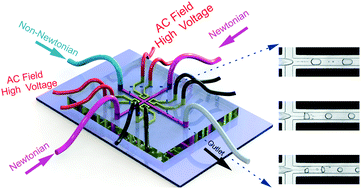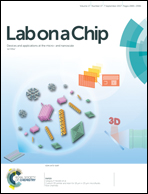AC electric field controlled non-Newtonian filament thinning and droplet formation on the microscale†
Abstract
Monodispersity and fast generation are innate advantages of microfluidic droplets. Other than the normally adopted simple Newtonian fluids such as a water/oil emulsion system, fluids with complex rheology, namely, non-Newtonian fluids, which are being widely adopted in industries and bioengineering, have gained increasing research interest on the microscale. However, challenges occur in controlling the dynamic behavior due to their complex properties. In this sense, the AC electric field with merits of fast response and easiness in fulfilling “Lab on a chip” has attracted our attention. We design and fabricate flow-focusing microchannels with non-contact types of electrodes for the investigation. We firstly compare the formation of a non-Newtonian droplet with that of a Newtonian one under an AC electric field and discover that viscoelasticity contributes to the discrepancies significantly. Then we explore the effect of AC electric fields on the filament thinning and droplet formation dynamics of one non-Newtonian fluid which has a similar rheological behavior to bio samples, such as DNA or blood samples. We investigate the dynamics of the thinning process of the non-Newtonian filament under the influence of an AC electric field and implement a systematic exploration of the non-Newtonian droplet generation influenced by parameters such as the flow conditions (flow rate Q, capillary number Ca), fluid property (Weissenberg number Wi), applied voltage (U) and frequency (f) of the AC electric field. We present the dependencies of the flow condition and electric field on the non-Newtonian droplet formation dynamics, and conclude with an operating diagram, taking into consideration all the above-mentioned parameters. Results show that the electric field plays a critical role in controlling the thinning process of the filament and the size of the generated droplet. Furthermore, for the first time, we quantitatively measure the flow field of the non-Newtonian droplet formation under the influence of an AC electric field, assisted by a high-speed micro particle imaging velocimetry (μPIV) system. The flow field distributions obtained using the correlation algorithm show that the electric field generated Maxwell stress deforms the interface, changes the flow recirculation pattern, stimulates the instability and hence reduces the size of the non-Newtonian droplet. Finally, we analyze the impact of Maxwell stress by means of the electric capillary number CaE. Our findings reveal the rich physics of non-Newtonian fluids and widen the applications of electric field in non-Newtonian environments, which could be critical for bioengineering.



 Please wait while we load your content...
Please wait while we load your content...